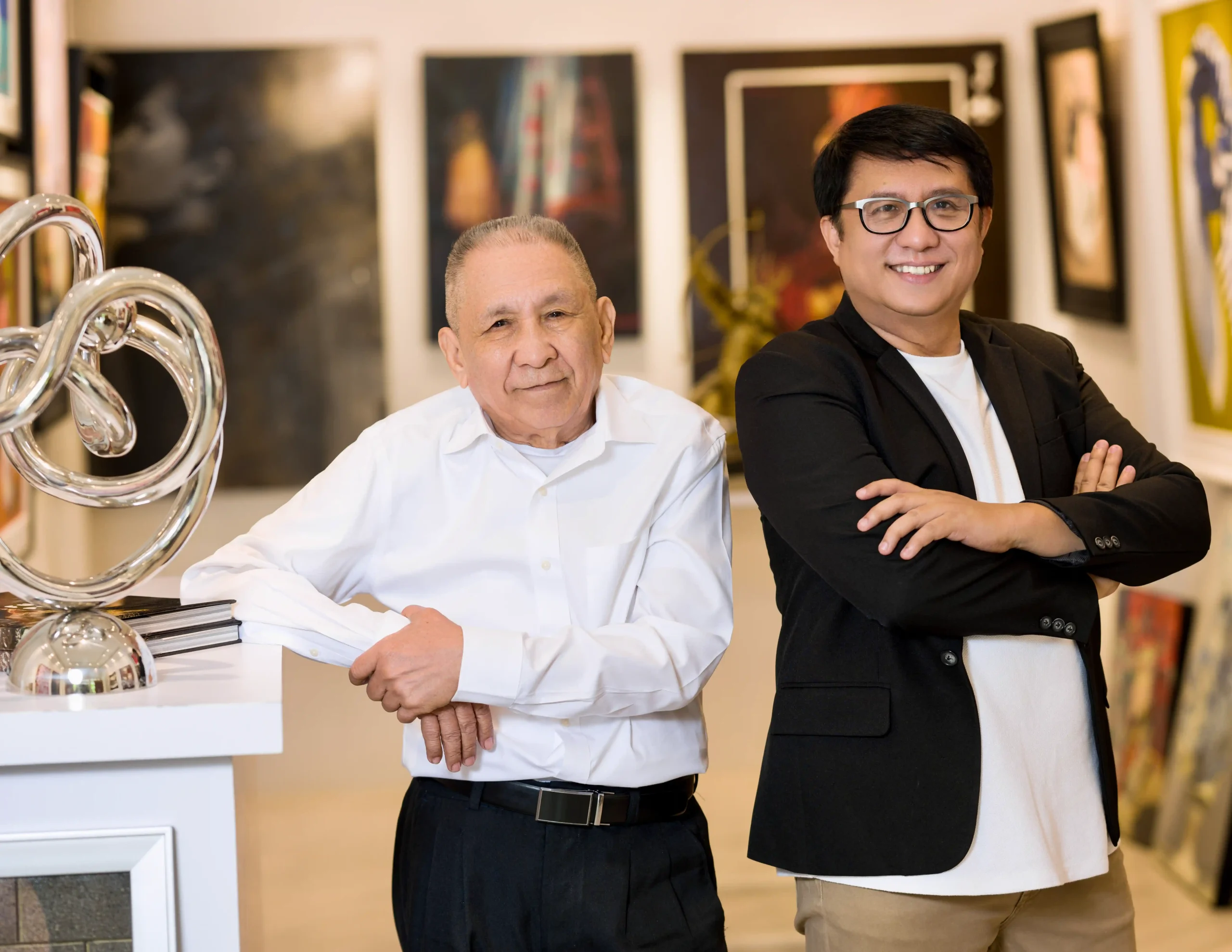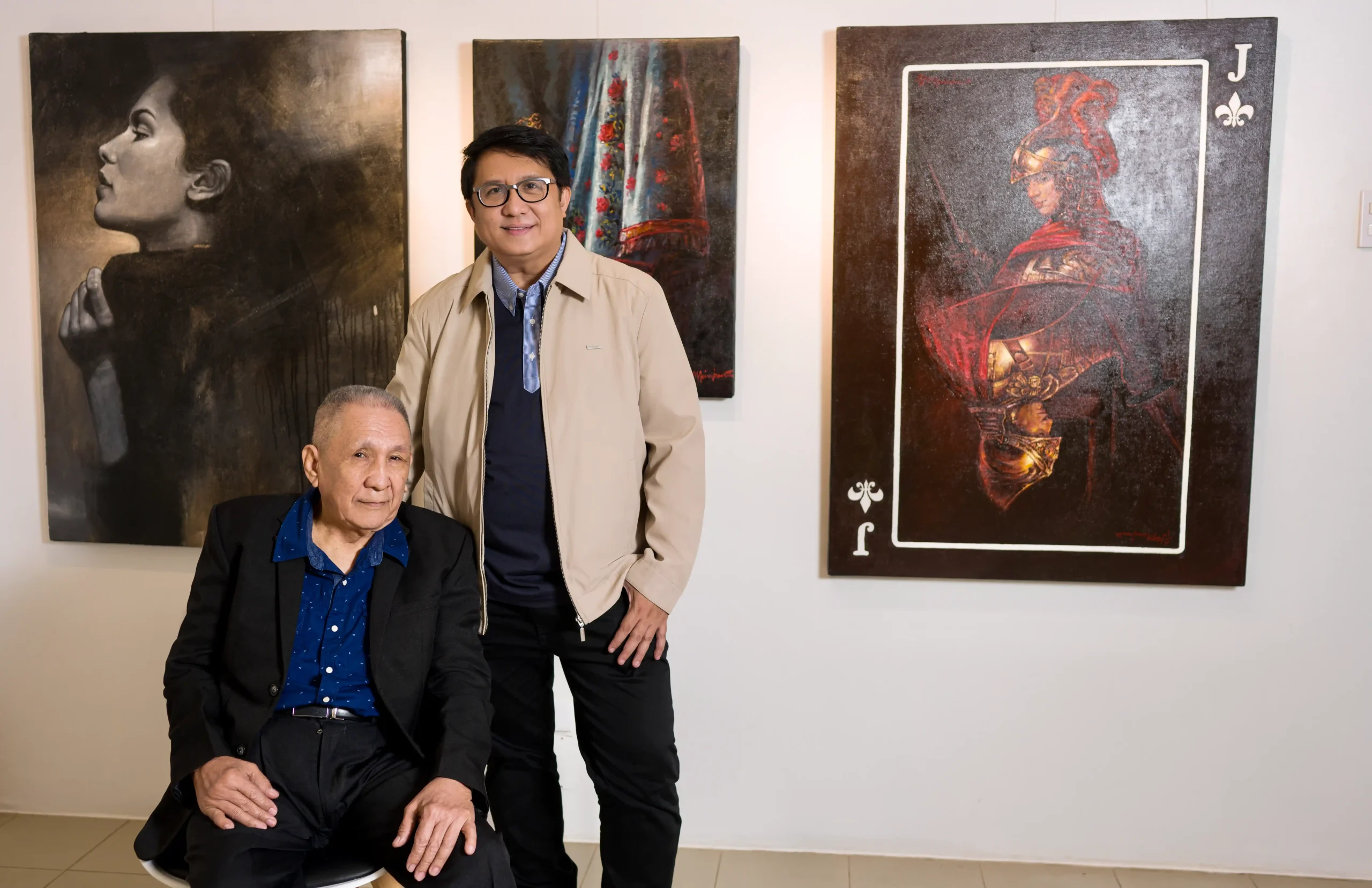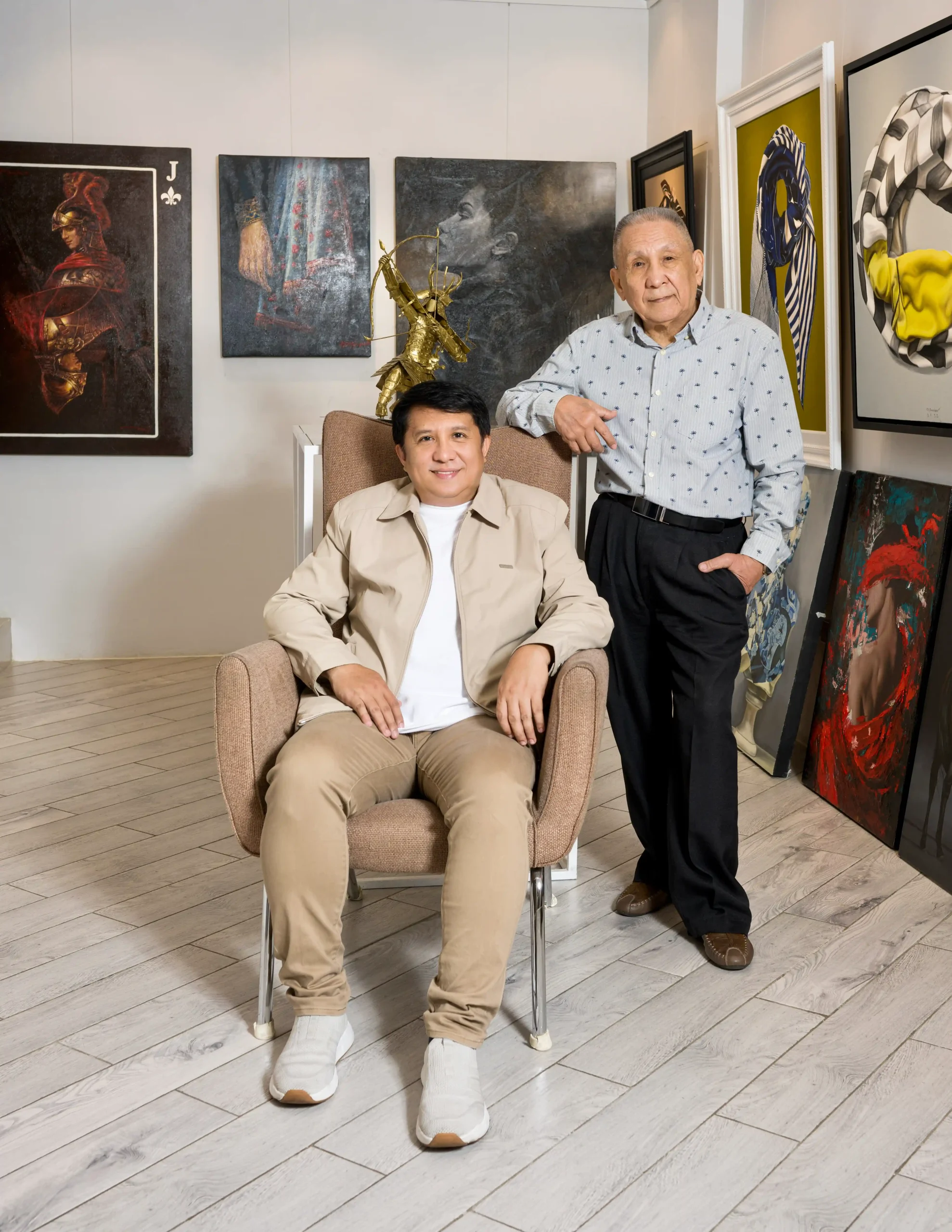Father and son artists Ely and Norlie Meimban shares their passion for painting and helping young artists find their footing in the grueling art industry.
I met Norlie Meimban in 2018 at the fifth installment of his UNNATURAL group show, UNNATURAL 5, at J Studio in Makati City. I was tasked to write a profile highlighting his journey as an artist and curator back then. As he walked me through his work, what piqued my interest was his ability to bring together a diverse group of artists from just about every walk of life, stage in their careers, and art style and medium. Each piece was unique to its creator and stitched together with a singular vision of crafting something truly their own.

Throughout our discussion, it was evident that Norlie had a knack for spotting talent and cultivating artists. UNNATURAL is not just an exhibit for established visual artists; it’s an incubator and platform for up-and-coming talents to showcase their works. In the grueling and competitive world of visual art, he has carved out a space for those who need it most: talented individuals with little to no connections to catch their break.
More than an artist and curator, Norlie mentors the younger generation of creatives, taking them under his wing and helping them navigate the industry.
“Not everyone who paints is an artist,” Norlie shares. “It’s those who truly live and breathe art that I consider as artists; those who know that this is their calling and nothing else would be enough.”
Creating something beautiful is one thing, but doing it as a living is another, and Norlie knows what it takes to become a working artist and not just an elusive nameplate under a canvas.
“People say that there is no money in art, that you would have to be a ‘Master’ to make it big or else you would go hungry, but I know art can be a living,” he says of the profession. “My father is an artist, and he was able to raise and sustain our family.”
His father’s hard work and consistency in his craft inspired Norlie to pursue his journey in art and mentor younger artists to do the same.
A Family Affair
Since childhood, Norlie has watched his father, Ely Meimban, paint canvas after canvas during the renowned Mabini Art Movement in the 70s. Ely made it a point that his son saw him working, teaching him how to handle a brush and tell stories through a canvas.
“Norlie is an artist because it’s in his blood,” Ely proudly shares. “My uncles on my mother’s side were artists, and now my son and even my son-in-law and grandchildren are also artists.”
It’s not unusual to see children following in their parent’s footsteps. There are families of doctors, law firms built by a group of extended families, and businesses passed through generations of entrepreneurs. But art—as personal as it is—is not a usual craft practiced by a nuclear household, and Ely knows of the struggles of being an artist in a family of painters.
“When I was starting, I asked my uncles to mentor me. But they told me I wasn’t born to be an artist because we didn’t share the same family name. They said I was better off pursuing my father’s line of work,” Ely spoke of his start in the industry.
“They wouldn’t even let my father see them work or teach him how to draw,” Norlie continued on his father’s search for a break in the field. “It was only until his best friend and mentor, Mariano Bautista, took him in as an apprentice that he found his footing.”
Ely began his career as a painter for cinema houses in 1965. During that time—what we now consider the “Golden Age of Cinema”—movie posters were painted by hand.
“It was hard at first because artists were very secretive about their techniques. No one wanted to share how they did their work, so I had to study on my own,” Ely narrates of the early stages of his career. “They would even discard their notes and wash their palettes before letting me clean their space when I was an apprentice.”
But Ely persevered to create a living as a painter. He found a mentor that cared for his growth. From painting movie posters, Ely’s mentor moved on to creating masterful artworks people wanted to buy and hang in their homes—and so did he.

“During the Mabini Art Movement from the 50s to the 90s, it became easier for people to buy art because of all the artists who painted with distinctive styles like the Filipino master artists,” explained Norlie. “That’s where my father grew as an artist.”
But not all artists’ stride for notoriety and success is paved the same way. There were times when Ely couldn’t find a shop to sell his pieces, and he wanted to go back to painting for cinema houses because of the financial implications of these setbacks.
“I didn’t even have money for my materials. I had to reconsider my options because I had a family to feed,” Ely spoke of his struggles.
When his mentor heard of this, he encouraged Ely to stay on track and gave him the materials he needed to create his work.
“That taught me to fight for what I learned and trust my skills as an artist,” Ely reminisces. “I felt like I owed it to my mentor to work hard and find my way. I started to befriend framers along Mabini Street and displayed my work at their shop; through that, I met people who took a liking to my work and commissioned me to create more pieces. I had to work hard in this industry and make sacrifices because I was starting a family with my wife and Norlie, and I didn’t want to waste the hard work and trust my mentor placed on me.”
Ely’s grit and perseverance taught Norlie early on that there’s room for artists to succeed in this world. “I never thought that I would go hungry or that I wouldn’t be able to provide for my own family if I pursued art because my father did everything he could to provide for us with his work,” Norlie shares.
When it was time for Norlie to pick a track to study in college—with his father’s encouragement, the support of a family friend and his father’s mentee, and a financial scholarship—he decided to take Fine Arts in Painting at the University of the Philippines Diliman (UP). On top of the lifelong education he got from his father, Norlie gained formal training in art history, techniques, concepts, and the industry at large.
“I experienced culture shock when I entered UP. I was used to seeing art in terms of technique and composition, but then I learned about concepts and storytelling in art. And I shared what I learned from school with my father,” Norlie reflects on his time in university.
“I wanted Norlie to study fine arts because he had a natural knack for it. He started drawing at an early age, and he would help me sketch. I saw that he had talent as an artist,” Ely shares.
After finishing his degree in fine arts, Norlie worked as an artist at an acclaimed animation studio. During this time, his father encouraged him to continue painting and not to forget his passions. While working at his day job, Norlie also joined art competitions—like the Metrobank Art and Design Excellence competition, which he won three times—and moonlit as a visual artist for companies like Saint Luke’s Hospital.
In 2002, twelve years into his career as an animator, he decided to move on and find his way back to painting. When he re-entered the art scene, Norlie felt out of his depth. The art world has changed so much, and the peers he began with were already gaining notoriety. At that point in his career, he was what the industry would call a mid-career artist—an artist who has gained recognition and accolades for his work but not the fame of a blue-chip artist.
Though challenged by his circumstances, his friends and father advised Norlie to try his hand at mounting an exhibit—as he did early on in his career—to bring traction to his work. That’s how his annual group show, UNNATURAL, and his connection to mentoring younger artists came about.
The Master and the Professional
Art, as a craft, is very personal. Though formal education can contribute to the fundamentals of an artist, it’s years of experience, trial and error, and success and failures that truly shape an artist. That’s why an apprenticeship can be a game-changer for young creatives.
“Early on, I saw my father take in young artists as apprentices,” recalls Norlie. “We even had someone who lived with us for twelve years while he studied under my father. He later moved on to become a celebrated artist. The most important thing I learned from my father is to never be selfish with your art and your knowledge,” shares Norlie. “He’s very generous of his time and talent. He makes sure that the artists he mentors become talented and professional painters.”

For over five decades, Ely has been Tatay (father in Filipino) to many artists who put their trust in him and his training. He teaches them the fundamentals but also requires them to live in his home to fully immerse themselves in his work ethic, creative practices, and life as an artist.
“It’s how Norlie learned. I didn’t just teach my son how to paint; he grew up seeing and observing how I work as an artist,” Ely shares. “I want my students to dedicate themselves to the craft so that when they go out on their own, they can carry themselves and become true professional artists.”
“As a mentor, you’re the first partaker of the knowledge you share,” Ely explains. “What you teach comes from your own experiences and reflections. And when a student asks you to teach them something you’re unfamiliar with, you also have to study and grow to become a better teacher. Sometimes, your students help open your eyes to new ideas you haven’t considered before.”
“I’ve learned a lot about mentoring from my father, and I added to what I’ve observed from him through the years. He’s very good at counseling—he’s also a counselor at our church. And I’ve picked up a few things throughout my own experiences and added to what I’ve observed from him to create my mentoring style,” Norlie explains. “I’ve met plenty of young artists that are talented in painting but don’t know how to act as professional artists. That’s why when I mentor, I make sure to teach them how to navigate the industry, price their work, manage their time, and have longevity as artists.”
ELY MEIMBAN @elymeimban
NORLIE MEIMBAN @artofnorliemeimban
Writer: TIMOTHY DIAO @timdiao
Copy Editor: KIEDO VILLANUEVA @kei_villanueva
Art Director: NIGEL JOHN DEL MUNDO @nigeldelmundo
Fashion Stylist: LILLIBETH MENDOZA MEIMBAN @lillibethmeimban
Location Manager: BERNARD PETER ONG
Photographer: VINCENT GOTTI @vinniegotti
Photographed at: M GALLERY Manila @mgallery.mnl

